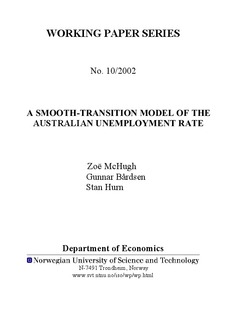| dc.contributor.author | Bårdsen, Gunnar | nb_NO |
| dc.contributor.author | Hurn, Stan | nb_NO |
| dc.contributor.author | McHugh, Zoë | nb_NO |
| dc.date.accessioned | 2014-12-19T14:32:00Z | |
| dc.date.available | 2014-12-19T14:32:00Z | |
| dc.date.created | 2006-10-10 | nb_NO |
| dc.date.issued | 2002 | nb_NO |
| dc.identifier | 126134 | nb_NO |
| dc.identifier.uri | http://hdl.handle.net/11250/267187 | |
| dc.description.abstract | Models of the aggregate unemployment rate have traditionally been estimated from structural models of the labour market or in a linear single-equation framework. However, theory as well as evidence suggest that the unemployment rate is asymmetric and should be modelled in a non-linear framework. In this paper the unemployment rate in Australia is modelled as a non-linear function of aggregate demand and real wages. Negative changes in aggregate demand cause the unemployment rate to rise rapidly, while real wage rigidity contributes its to slow adjustment back towards a lower level of unemployment. The model is developed by exploiting recent developments in automated model-selection procedures. | nb_NO |
| dc.language | eng | nb_NO |
| dc.publisher | Norges teknisk-naturvitenskapelige universitet, Fakultet for samfunnsvitenskap og teknologiledelse, Institutt for samfunnsøkonomi | nb_NO |
| dc.relation.ispartofseries | Working Paper Series, 1503-299X; 2002:10 | nb_NO |
| dc.title | A Smooth-Transition Model of the Australian Unemployment Rate | nb_NO |
| dc.type | Research report | nb_NO |
| dc.contributor.department | Norges teknisk-naturvitenskapelige universitet, Fakultet for samfunnsvitenskap og teknologiledelse, Institutt for samfunnsøkonomi | nb_NO |
